With one click
Export a perfectly formatted traditional script.
From shorts to features, there are entire films made today that have little to no dialogue. And the screenplays for these films are often the perfect example of what a screenplay should be, a demonstration of showing and not telling, using only visual storytelling techniques.
Export a perfectly formatted traditional script.

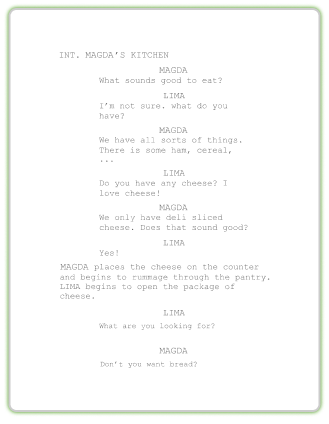
We asked Screenwriter Doug Richardson (“Bad Boys,” “Die Hard 2,” “Hostage”) what he believes are the keys to success for storytelling without dialogue.
“Oh, that’s very simple,” he told us. “How to write a screenplay with little or no dialogue, and how to keep the reader engaged? It’s a very simple thing. Tell a story that makes the reader want to turn the page.”
Screenplays are blueprints for a film, and so much more than dialogue. The theme, setting, sound, characters, expression, action beats, and more go into visual storytelling. You need all of this to work in tandem to tell the story effectively. Let’s not forget where it all began: Silent films, where they “didn’t need dialogue. [They] had faces,” as Norma Desmond proudly exclaims in Billy Wilder’s “Sunset Boulevard.”
Describe what the audience is seeing, including the setting and any action that the character is taking
Include sounds, even when there are no words
Consider what your character is doing that could further the story
Separate every new location with a heading in CAPS that includes INT. or EXT (interior or exterior) – short location description – and time of day (MORNING, NIGHT, DUSK, Etc.)
Give your characters distinguishable characteristics
Keep action sentences short and to the point, so you script lines are more vertically oriented than horizontal
“Make them turn the page,” Richardson concluded.
Take “Shaun the Sheep” for example, written and directed by Mark Burton and Richard Starzak. The screenplay paints a vivid picture, sans any dialogue from the characters, except for a few grunts and mumbles. “WALL-E” written by Andrew Stanton, Jim Reardon, and Pete Doctor, is a movie with a big message, but very little dialogue. And “A Quiet Place” is just that, a quiet movie void of dialogue and full of terrifying suspense if a character dares make a noise. Bryan Woods, Scott Beck, and John Krasinski wrote the screenplay.
“It’s that simple,” Richardson continued. “Be compelling. If you put something on paper … and you start telling a story in such a way that the reader has to know what happens next, you don’t need dialogue. You just need skill, talent, and a great story.”
To write a story in SoCreate with little no dialogue, you’ll rely heavily on your Location and Action Stream Items.
You may still use Characters and Dialogue Stream Items to help illustrate character noises or facial expressions.
Here’s an example of what a scene with very little dialogue might look like. Note that this example uses tools such as Dialogue Direction and Dialogue Type to better illustrate visually what the characters are doing, despite no dialogue being spoken.
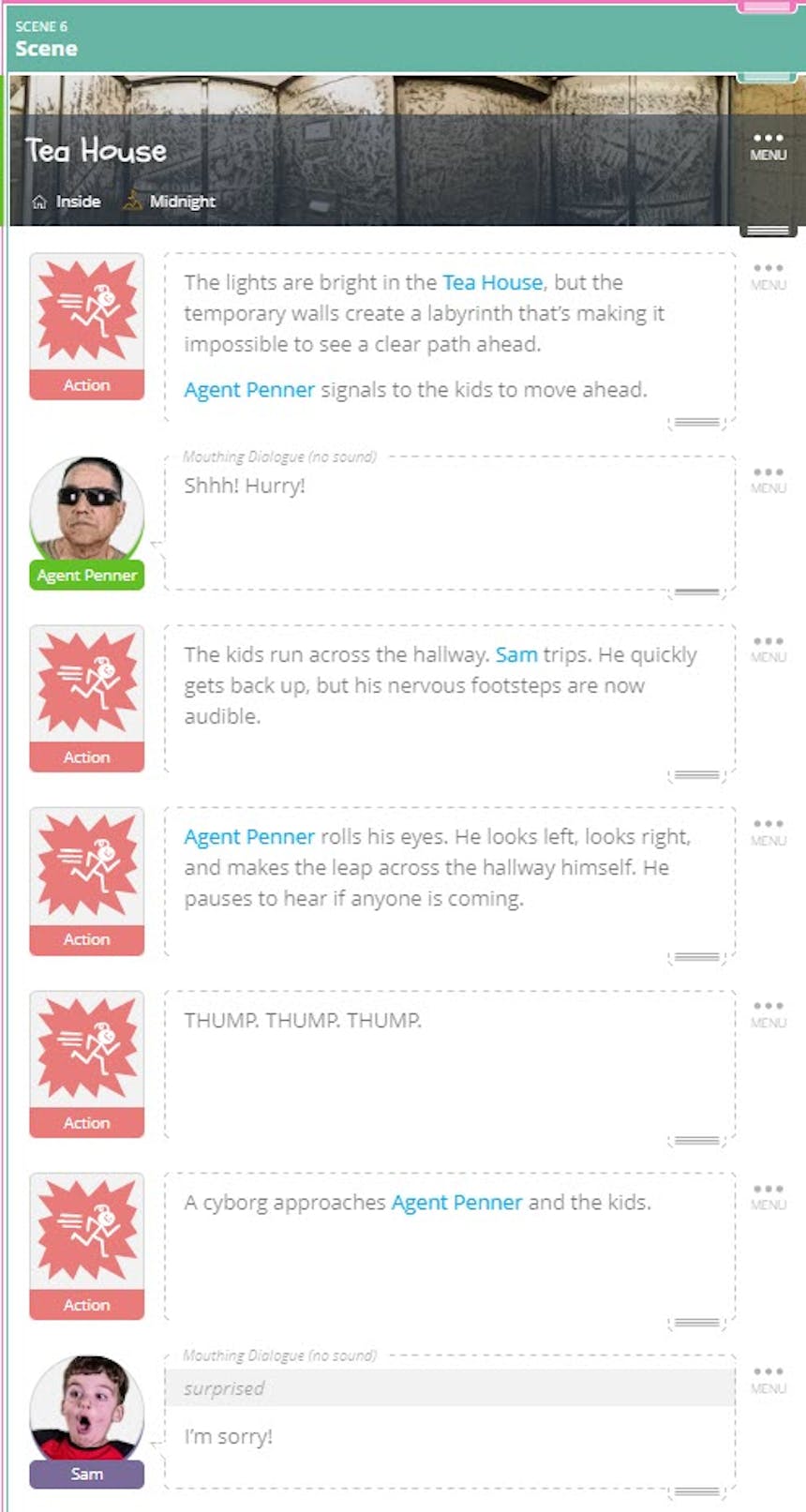
To add Dialogue Type, which appears as a notation above the dialogue to indicate to the reader that this is not simple on-camera dialogue, click into the Dialogue Stream Item you wish to edit. Find the icon that looks like a person speaking.
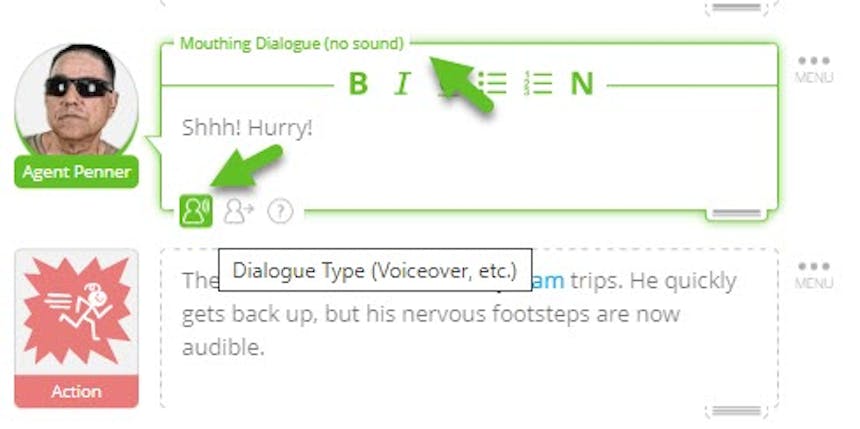
Options such as Mouthing Dialogue, Sign Language, and Text Message could be used to illustrate that dialogue is somehow being communicated, but not spoken.
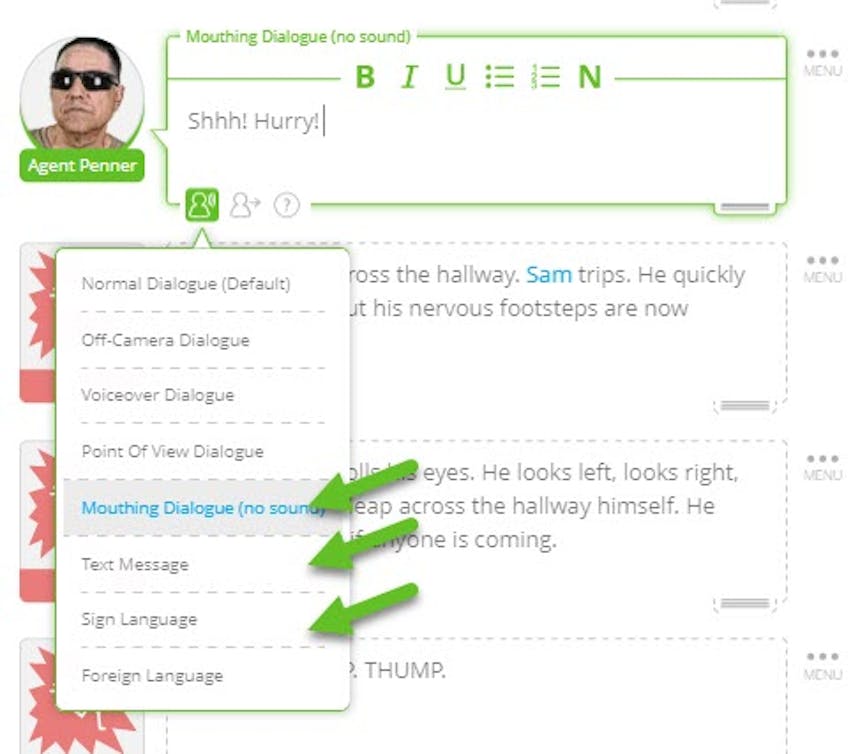
If you decide to export your SoCreate story to the traditional screenplay format, Dialogue Type will show in parentheses immediately to the right of the name of the character who is delivering the line.
Character expressions are paramount in screenplays with little to no dialogue. A picture is worth one thousand words, as they say! You can note the expression on a character’s face using the Action Stream Item or using Dialogue Direction.
By using Dialogue Direction, your readers will get a visual cue of what the character is doing, since character faces have 15 different alternate expressions within the SoCreate app. If you indicate in Dialogue Direction that your character is crying, screaming, laughing out loud, falling asleep, and more, your character image will change to match .
To use Dialogue Direction, click into the Dialogue Stream Item you wish to edit. Then, find the icon that looks like a person with an arrow next to it.
Clicking here will open up a grey box above your dialogue where you can explain how the character is meant to deliver the line.
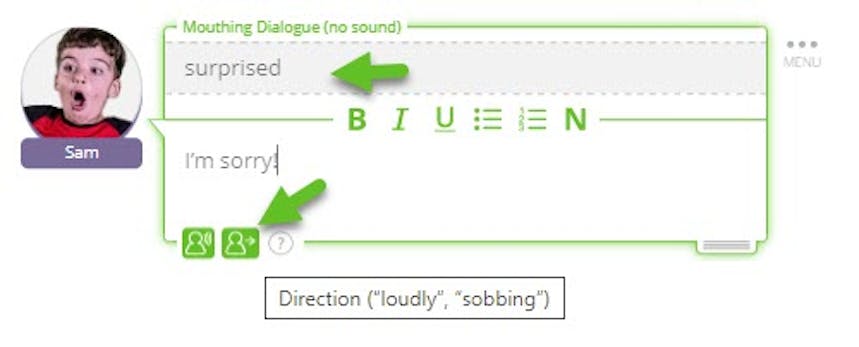
If you decide to export your story to the traditional screenplay format, Dialogue Direction will appear in parentheses immediately beneath the character’s name who’s assigned that line.
Movies and TV shows are visual mediums, so dialogue is not a necessary part of the equation. It’s a great exercise in showing and not telling! SoCreate makes it easy to write screenplays with little to no dialogue, while breaking up large blocks of text you might find in a traditional screenplay that’s written this way. SoCreate keeps things visual with easy tools such as Action, Dialogue Type, and Dialogue Direction.
Now shhh, I’m writing over here.

